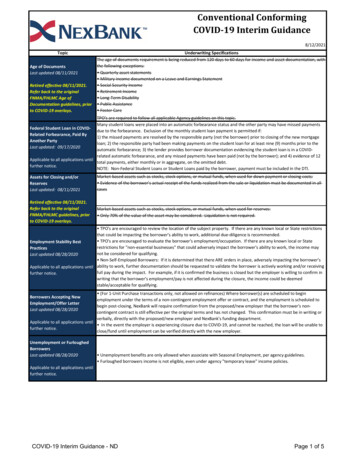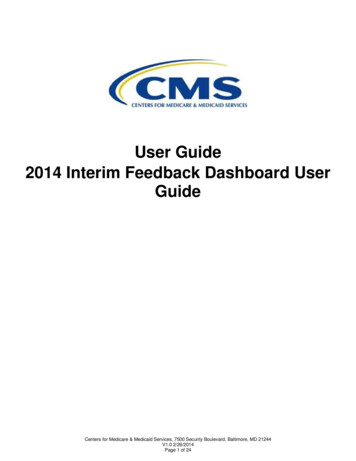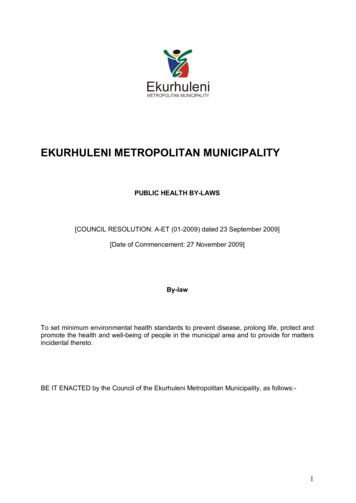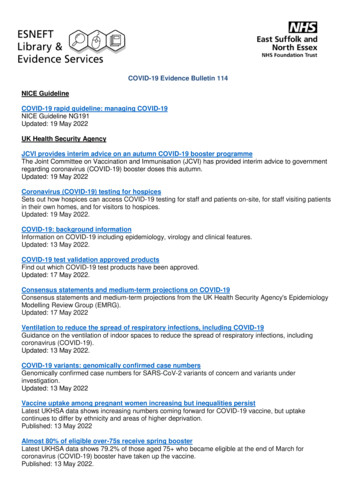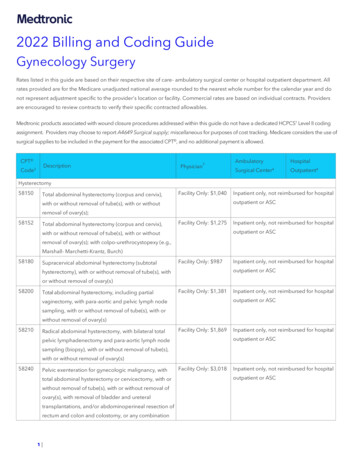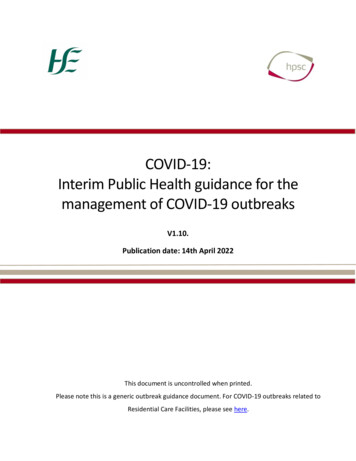
Transcription
COVID-19:Interim Public Health guidance for themanagement of COVID-19 outbreaksV1.10.Publication date: 14th April 2022Interim Public Health Guidance on the Prevention andManagement of 19 OutbreaksV0.1 17/04/20This document is uncontrolled when printed.Please note this is a generic outbreak guidance document. For COVID-19 outbreaks related toResidential Care Facilities, please see here.
ContentsSummary . 5Abbreviations . 6General approach to outbreak management . 7Aim and scope of the plan . 8Legislative obligations and role of Medical Officer of Health . 8Roles and responsibilities. 9COVID-19 Background information . 9Transmission . 10Incubation period . 11Survival in the environment . 11Clinical features of COVID-19 . 11Laboratory testing . 12Rapid Antigen Detection Tests (RADTs) . 13Vaccination. 13COVID-19: Management of the outbreak . 13Planning. 13Outbreak investigation objectives and functions . 14Monitoring outbreak progress . 18Risk management. 20Risk communication . 20Declaring the outbreak over . 21Audit, evaluation and documentation . 22Appendix A: Roles and responsibilities of OCT members . 23Appendix B: Principal infectious disease legislation; Ireland . 27Appendix C: Roles and responsibilities during COVID-19 pandemic response. 28Appendix D: Standards for managing outbreaks . 32Appendix E: Checklist for outbreak management . 33Appendix F: Decision making log . 35Appendix G: Recommended actions log . 36HSE Health Protection Surveillance Centre. www.hpsc.iePage 2 of 48
Appendix H: Generic example of outbreak report structure . 37Appendix I: Prevention and control of outbreaks of COVID-19 . 38Appendix J: Proposal for occupational health supports . 40Appendix K: Details for line listing . 44Appendix K: Part 1 – Respiratory outbreak line listing Form – Patients/Cases ONLY* . 45Appendix K: Part 2 – Patients/Cases ONLY . 46Appendix K: Part 3 – Respiratory outbreak line listing form – Staff ONLY* . 47Appendix K: Part 4 –Staff ONLY* . 48HSE Health Protection Surveillance Centre. www.hpsc.iePage 3 of 48
Version HistoryVersionDateChanges from previous versionDrafted by1.1014/04/2022Review of documentHPSC1.908/02/2022Added in reference to widespread use of antigen testing1.819/01/2022Update wearing of FFP2 masks for healthcare workers interacting with patientsHPSC1.706/01/2022Update Section 5.6.2 immunityHPSC1.623/06/2021Added information about vaccinationHPSC1.501/06/2021Incorporates changes to immunity period post infectionHPSC1.407/04/2021Added caveat that guidance does not apply to variants of concernHPSCClarified that 6 months of presumed immunity does not apply for close contacts of suspectedor confirmed VOC case1.312/03/2021Incorporates changes to immunity.HPSCReplaces terminology regarding ‘medically vulnerable’ with ‘high risk’ and ‘extremelymedically vulnerable’ with ‘very high risk’.1.218/02/2021Clarified face protection in Appendix IHPSC1.117/05/2020Addition of table of acronymsClarification in summary box regarding the practical implications of implementing this planHPSCHSE Health Protection Surveillance Centre. www.hpsc.iePage 4 of 48
SummaryIt is important to note the following in relation to this COVID-19 Outbreak ManagementPlan: the principles in this plan may be applied to any COVID-19 outbreak but some ofthe suggested actions may only be practical or necessary in certain outbreaksituations and where there are adequate resources for implementation, forexample in Residential Care FacilitiesAn outbreak of COVID-19 can happen in a variety of settings e.g. the home, community,residential care facilities, hospitals and the workplace. The most up to date surveillancedefinition of an outbreak of COVID-19 is available on the HPSC website.Due to the variation in outbreak settings, the risk level for those involved or potential forincreased transmission, a more sensitive definition of an outbreak may be used for publichealth action.Testing should be arranged where recommended. However, it is not necessary to wait fortest results before beginning initial investigation, contacting Public Health and implementingcontrol measures.For setting specific guidance please see the following supplemental documents: Interim guidance for the management of COVID-19 in Residential Care FacilitiesSupplemental guidance for the management of outbreaks in the acute hospitalsettingSupplemental guidance for the management of outbreaks in general communitysettings – in progressNote: Infection prevention and control precautions guidance should be followed during thepreparedness and response phases of all outbreaks.HSE Health Protection Surveillance Centre. www.hpsc.iePage 5 of 48
RCOVID HPRAHPSCHSELTCFLGDMDTMOHNCMTNIONHNHP PHMSpRWHOWPHWAlcohol Based Hand RubAre Crisis Management TeamAerosol Generating ProcedureAcute Respiratory InfectionChief Executive OfficerChief Clinical OfficerCommunity Healthcare OrganisationCommunity Infection Prevention and Control Nurses' networkChief Medical OfficerContact Management ProgrammeComputerised Infectious Disease Reporting (system)Coronavirus disease 19Contact response managementDate of BirthDepartment of HealthDirectors of Public HealthExpert Advisory GroupEmployee Assistance ProgrammeEuropean Centre for Disease ControlEuropean Programme for Intervention Epidemiology TrainingFiltering Face PieceGeneral PractitionerHealth Care WorkerInfectious DiseasesInfection Prevention ControlInfection Prevention Control NurseHealth Information and Quality AuthorityHealth Products Regulatory AuthorityHealth Protection Surveillance CentreHealth Service ExecutiveLong Term care facilityLead Government DepartmentMultidisciplinary TeamMedical Officer of HealthNational Crisis Management TeamNational Immunisation OfficeNursing HomeNational Health Protection Pandemic Incident Control TeamNational Public Health Emergency TeamNational Virus Reference LaboratoryOutbreak Control TeamOccupational HealthPersonal Protective EquipmentResidential Care FacilityReverse Transcription Polymerase Chain ReactionSevere acute respiratory syndrome coronavirus 2Situational ReportSenior Medical OfficerSpecialist in Public Health MedicineSpecialist RegistrarWorld Health OrganizationWorkplace Health and WellbeingHSE Health Protection Surveillance Centre. www.hpsc.iePage 6 of 48
General approach to outbreak managementThere are five crucial elements in developing an effective, standardised approach to theinvestigation and management of outbreaks of Coronavirus disease (COVID-19). These crucialelements are:1.Effective pre-planning and preparation;2.A very high degree of clarity regarding governance structures and the roles andresponsibilities of all stakeholders involved in outbreak management;3.Robust collaborative arrangements between partner organisations;4.Clear, simple and unambiguous communications policies and pathways within andbetween partner organisations;5.A well-developed outbreak plan which clearly describes the above components.Partner organisations should familiarise themselves with one another’s roles and responsibilitiesduring outbreak management; this is best achieved through clear lines of communication andtraining.This operational plan describes roles and responsibilities of a range of organisations tasked withthe identification, investigation and control of outbreaks of COVID-19, at local, regional, nationaland international level.This plan should be used in conjunction with other relevant plans and guidance for COVID-19.This information is available from the following links: HSE-HPSC HSE Hub Department of HealthHSE Health Protection Surveillance Centre. www.hpsc.iePage 7 of 48
Aim and scope of the planThe aim of this plan is to ensure a rapid, effective and coordinated approach to the identification,investigation and control of an outbreak of COVID-19, regardless of setting. The plan describesthe continuum of outbreak management, from initial detection to the formal declaration of theend of the outbreak and written review of lessons learned.The plan identifies the roles and responsibilities of key stakeholders, describes managerial andorganisational aspects of the COVID-19 outbreak response, and outlines communication,investigation and control procedures.NB: The protection of public health takes priority over all other considerations, and this mustbe understood by all members of the Outbreak Control Team (OCT). Appendix A outlines anexample of membership of the OCT.The objectives of this plan are: To provide an overarching framework for investigation and management of COVID-19outbreaks. To ensure that outbreaks of COVID-19 are effectively and rapidly identified, verified,investigated, brought under control and, where necessary, procedures put in place toreduce the likelihood of similar outbreaks occurring in the future. To ensure that legislative controls are applied appropriately and correctly, in consultationwith relevant partners.Legislative obligations and role of Medical Officer of HealthUnder the Infectious Disease Regulations 1981, all medical practitioners, including clinicaldirectors of diagnostic laboratories, are required to notify the Medical Officer of Health (MOH)of cases and outbreaks of Notifiable Infectious Diseases. It is the legislative responsibility of theMOH to “make such enquiries and take such steps as are necessary or desirable for investigatingthe nature and source of such infection, for preventing the spread of such infection and forHSE Health Protection Surveillance Centre. www.hpsc.iePage 8 of 48
removing conditions favourable to such infection.”1 The role of the MOH can include conveningan OCT as appropriate, which should comprise the necessary expertise to manage/control theoutbreak. In investigating an outbreak of a notifiable infectious disease, the OCT must always beaware of the possibility of legal proceedings arising from the incident and should therefore takewhatever steps are necessary to maintain chain of evidence that may be required for subsequentlegal action.Appendix B lays out the relevant legislation governing the notification and management ofoutbreaks of notifiable infectious diseases.Roles and responsibilitiesA brief description of national and regional groups involved in the development andoperationalisation of the pandemic plan is outlined in Appendix C.COVID-19 Background informationCOVID-19 is an illness, identified in late 2019, caused by a virus called SARS-CoV-2. Internationallyand in Ireland we continue to learn about how easily the virus spreads from person to personand how to control it. Although the impact of COVID-19 has had a profound effect on manypeople in our society, we have made significant progress in learning how to live with the disease.The vast majority of people in Ireland now have a good degree of protection against severedisease and hospitalisation due to the rollout of the vaccination programme.Effective vaccines against COVID-19 are available and a robust vaccination programme has beenimplemented in Ireland. Viruses constantly change and mutate due to evolution and adaptationprocesses. As a consequence, the emergence of new variants is to be expected.1INFECTIOUS DISEASES (AMENDMENT) REGULATIONS 2020, S.I. No. 53 of 2020Health (Preservation and Protection and other Emergency Measures in the Public Interest) Act 2020, Number 1 of2020HSE Health Protection Surveillance Centre. www.hpsc.iePage 9 of 48
The available evidence at this time regarding real world vaccine effectiveness and duration ofprotection shows that all vaccines authorised in the EU/EEA are currently highly protectiveagainst hospitalisation, severe disease and death for a variety of strains of COVID-192. This doesnot mean that individuals are immune from SARS-CoV-2 infection once vaccinated. People whoare vaccinated may still be able to transmit SARS-CoV-2 infection to susceptible contacts3.TransmissionThe virus that causes COVID-19 is spread through exposure to very small respiratory liquidparticles released in the exhaled breath of an infectious individual. Current evidence indicatesthat respiratory liquid particles travel through the air over variable distances and can causeinfection if they are inhaled. This risk increases if individuals are in close proximity and/or over aprolonged period of time. These respiratory particles can travel over longer distances i.e. morethan 2 metres and the evidence would suggest that this is most likely to happen in crowdedindoor environments with prolonged exposure and when the ventilation in a room is poor.4Certain procedures, known as Aerosol Generating Procedures (AGP), can create the potential forairborne transmission. Further information on ventilation, AGPs and COVID-19 is available on theHPSC website.Individuals are considered most infectious around one day before symptom onset with anaverage period of infectiousness and risk of transmission between 2-3 days before and 8 daysafter symptom onset.5 The exact duration of when COVID-19 patients are infectious is unknownand is likely to vary between variants as well as between patients. It is dependent on manyfactors, but in particular, the individual’s immune status, disease severity and the viral load towhich they have been exposed, as well as the type of contact. individuals-previous-infection4Morawska L. Droplet fate in indoor environments, or can we prevent the spread of infection? Indoor Air. 2019-ncov/faq.html#Basics6 ion-of-people-with-COVID-19-thirdupdate.pdf7Lee S, Kim T, Lee E, Lee C, Kim H, Rhee H, et al. Clinical Course and Molecular Viral Shedding Among Asymptomatic and Symptomatic PatientsWith SARS-CoV-2 Infection in a Community Treatment Center in the Republic of Korea. JAMA Internal Medicine. 2020;180(11):1447-52.Available at: E Health Protection Surveillance Centre. www.hpsc.iePage 10 of 48
Current evidence indicates that asymptomatic persons represent a source of transmissible SARSCoV-2.7Peak levels of viral loads are detected around the time of symptom onset. 8 In general,virus remains detectable in respiratory secretions for up to eight days in moderate cases andlonger in severe cases of COVID-19.Incubation periodCurrent estimates suggest that the time between exposure to the virus and developingsymptoms (incubation period) is from five to six days on average but can range from 2 to 14days. 9Survival in the environmentThe SARS-CoV-2 virus has an outer coating called a lipid envelope. The presence of the lipidenvelope means that virus is likely to survive for shorter periods outside the human bodycompared to a non-enveloped virus like Norovirus (Winter vomiting virus). The virus is easilykilled by common household cleaning products including bleach and disinfectants. Survival onenvironmental surfaces depends on the type of surface and the environmental conditions. Onestudy using a SARS-CoV-2 strain showed that it can survive for up to 72 hours on plastic, for 48hours on stainless steel and for up to eight hours on copper when no cleaning is performed. 10However, the levels of virus declined very quickly over the time period.Clinical features of COVID-19 11Most people with COVID-19 will have mild disease and will recover. A minority will develop moreserious illness. The National Immunisation Advisory Committee (NIAC) have defined a list /Evidence-Summary COVID-19 on10 van Doremalen, N. et al. Aerosol and surface stability of SARS-CoV-2 as compared with SARS-CoV-1. N. Engl. J. Med.https://doi.org/10.1056/NEJMc2004973 (2020).11 da Rosa Mesquita R, Francelino Silva Junior LC, Santos Santana FM, et al. Clinical manifestations of COVID-19 in the general population:systematic review. Wien Klin Wochenschr. 2021;133(7-8):377-382. doi:10.1007/s00508-020-01760-49HSE Health Protection Surveillance Centre. www.hpsc.iePage 11 of 48
underlying conditions associated with very high risk or high risk of severe COVID-19 disease. Pleasesee here for further information.Very high risk and high-risk groups should, where possible: get a COVID-19 vaccine get a booster dose wear a medical or respirator face mask in indoor or outdoor crowded places follow advice on how to protect yourself from COVID-19Further considerations for those at risk of severe disease of COVID-19 infection can be found here.The interim case definition is on the HPSC website. The most common signs and symptoms ofCOVID-19 are available on the HSE website.Laboratory testing Laboratory testing for SARS-CoV-2 is performed in the same way as testing forinfluenza. A viral swab is collected from the throat and nasopharynx. Only one swabis used to collect both samples, with the throat site sampled first. When testing is performed, ensure the correct swab type is taken (viral swab) and it isappropriately labelled. There must be two patient identifiers on both the swab andrequest form such as Name and date of birth (DOB). Details on the swab and request formmust match each other. Ensure that an outbreak code, contact name and telephonenumber (mobile preferably) for the person requesting the test (typically a clinician) areclearly visible on the request form. Deliver the sample to the testing laboratory as soonas possible. No diagnostic test is 100% sensitive and specific. If a test result comes back as “SARSCoV-2 not detected”, this is not definitive confirmation that the person is notinfected with the virus. If the person in question remains unwell with no alternativediagnosis then a diagnosis of COVID-19 is still possible.HSE Health Protection Surveillance Centre. www.hpsc.iePage 12 of 48
Rapid Antigen Detection Tests (RADTs)Rapid Antigen Detection Tests (RADTs) are now used widely within the community totest for the presence of COVID-19 infection. Please see here for further information.VaccinationEffective vaccines against COVID-19 are available. This is an additional and importantintervention to prevent the spread of the virus.COVID-19: Management of the outbreakPlanning Each Department of Public Health should identify a lead for COVID-19 preparedness andresponse coordination. The lead should be a person with sufficient authority to ensurethat appropriate action is taken and may require the support of a team including a liaisonperson for the outbreak setting. Acute and community settings must have COVID-19 preparedness plans in place toinclude planning for isolating confirmed or suspected cases (including temporaryconversion of day rooms etc to facilitate such), cohorting of cases (keeping people withCOVID-19 separate from those without COVID-19), enhanced infection prevention andcontrol (IPC) measures, staff training, establishing surge capacity and promoting case andfamily communication. Where possible, each ward or floor should try and operate as a discrete unit or zone,meaning that staff and equipment are dedicated to a specific area and are not rotatedfrom other areas (this includes night duty). This practice will help to reduce risk oftransmission in the event that COVID-19 is introduced into the facility and will allowoutbreak response measures to be targeted in zones, further mitigating risks. This maynot always be feasible in smaller facilities, but consideration should be given as to howclosely the facility can align to these recommendations. Facilities should ensure the availability of supplies including tissues, alcohol based handrub (ABHR), hand wipes, cleaning products (including disinfectants) and personalHSE Health Protection Surveillance Centre. www.hpsc.iePage 13 of 48
protective equipment (PPE) and liaise with local CHO management if there is difficulty inobtaining such supplies. A set of standards for managing outbreaks is outlined in Appendix D. A checklist of key interventions for the prevention and management of a COVID-19outbreak can be found in Appendix E.For more setting specific guidance on preparedness and response to COVID-19 outbreaks pleasesee the following supplemental documents: Interim guidance for the management of COVID-19 in Residential Care Facilities Supplemental guidance for the management of outbreaks in the acute hospital setting Note: Infection prevention and control precautions guidance should be followed duringthe preparedness and response phases of all outbreaks.Outbreak investigation objectives and functionsThe primary aims of outbreak investigation are to: Control the outbreak, Mitigate the effects of the outbreak, and Stop the outbreak by preventing further cases of COVID-19.The primary objectives of outbreak investigation are to: Determine/confirm that it is a COVID-19 outbreak, Identify the pathway(s) of transmission, Prevent generation of further cases, Plan and implement priority interventions/control measures to mitigate the effect ofthe outbreak, Bring the outbreak to an endThe key functions in managing outbreaks include the following: Identification and initial response; Investigation; Risk assessment;HSE Health Protection Surveillance Centre. www.hpsc.iePage 14 of 48
Surveillance, notification and reporting; Risk management; Risk communication; Audit, evaluation and documentation.Identification and initial responseOn recognition of an outbreak the following steps are important: all relevant agencies with a responsibility for the investigation and management of theincident are informed; steps are taken to gather further information about the cases and how they may havebeen exposed; an initial risk assessment is undertaken; urgent control measures are put in place to protect public health.Informed by an initial risk assessment and in consultation with relevant stakeholders, the MOHshould decide whether an investigation and specific control measures are required. These shouldbe implemented as soon as possible.InvestigationFrom the information gathered from the initial investigation, it may be possible to form a workinghypothesis about the route of exposure, level of exposure, nature and size of the populationexposed or likely to be exposed, and the degree of risk to public health. The MOH will then decidehow to progress a more comprehensive investigation.The investigation should typically consist of three elements: an epidemiological investigation; an investigation into the nature and characteristics of the outbreak; a specific investigation into how cases were exposed (e.g. hygiene in healthcare settings,no PPE) to inform control measures.Risk assessmentHSE Health Protection Surveillance Centre. www.hpsc.iePage 15 of 48
Based on information obtained and/or received from key stakeholders, the findings from theinvestigation and an assessment of the effectiveness of control measures taken, the MOH / OCTshould assess the ongoing risk to the public and to patients if the outbreak is in a hospital orsimilar community facility. The purpose of this assessment is two-fold, to assess: (i) whetherexposure is ongoing, and (ii) the impact of exposure (numbers affected and severity).Risk assessment essentially entails appraising the evidence collected in the incident investigationand determining whether it indicates that there is an ongoing significant threat to public health.The risk assessment should be dynamic and regularly reviewed by the MOH and should includethe following considerations:Severity: Dynamically assessed degree of foreseeable harm that may be caused to individuals orto the population and possible issues with recovery in the aftermath of the outbreak.Confidence: Knowledge, derived from all sources of information, that confirms the existence andnature of the threat and the routes by which it can affect the population.Spread: The size of the actual and potentially affected population.Interventions: The availability and feasibility of population interventions to alter the course andinfluence the outcome of the event.Context: The broad environment, including media interest, public concern and attitudes,expectations, pressures, strength of professional knowledge and external factors includingpolitical decisions. (STEEP criteria – social, technological, economic, environmental, political).Conclusions derived from the risk assessment are principally a matter of professional judgement.However, for reasons of public accountability and understanding, it is essential that this processis as transparent as possible. The MOH or the Health Officer on behalf of the MOH and/or OCTshould discuss and record in writing the outcome of the risk assessments. Once the risk has beenassessed, a decision should be made on how the risk is likely to be perceived by the public. Thisshould inform the development of specific public communications about the risk and how it isbeing mitigated.HSE Health Protection Surveillance Centre. www.hpsc.iePage 16 of 48
Outbreak Control TeamThe below is generic guidance for Outbreak Control Teams where they are convened. For specificguidance for Residential Care Facilities, please see here. All outbreaks of COVID-19 must be reported to the regional Medical Officer of Health(MOH) at the Department of Public Health at the earliest opportunity. The MOH from the Regional Department of Public Health has the responsibility toinvestigate, risk assess and manage an outbreak of COVID-19 as they deem appropriate. Following a risk assessment, the MOH will decide if an OCT if appropriate or not. An OCT can assist the MOH in discharging this responsibility. Ideally, the OCT should haveregular, active involvement of a Public Health Doctor. However, if that is not practicallypossible, following initial consultation and advice from Public Health the OCT should liaiseon a regular basis with the regional Department of Public Health to provide updates onoutbreak progress and seek further advice as appropriate. The OCT configuration should be decided at local level and will depend on availableexpertise. An OC
organisational aspects of the COVID-19 outbreak response, and outlines communication, investigation and control procedures. NB: The protection of public health takes priority over all other considerations, and this must be understood by all members of the Outbreak Control Team (OCT). Appendix A outlines an example of membership of the OCT.

